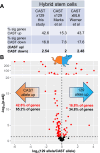Stem cell transcriptional profiles from mouse subspecies reveal cis-regulatory evolution at translation genes
- PMID: 39164520
- PMCID: PMC11527988
- DOI: 10.1038/s41437-024-00715-z
Stem cell transcriptional profiles from mouse subspecies reveal cis-regulatory evolution at translation genes
Erratum in
-
Correction: Stem cell transcriptional profiles from mouse subspecies reveal cis-regulatory evolution at translation genes.Heredity (Edinb). 2024 Nov;133(5):370. doi: 10.1038/s41437-024-00730-0. Heredity (Edinb). 2024. PMID: 39448876 Free PMC article. No abstract available.
Abstract
A key goal of evolutionary genomics is to harness molecular data to draw inferences about selective forces that have acted on genomes. The field progresses in large part through the development of advanced molecular-evolution analysis methods. Here we explored the intersection between classical sequence-based tests for selection and an empirical expression-based approach, using stem cells from Mus musculus subspecies as a model. Using a test of directional, cis-regulatory evolution across genes in pathways, we discovered a unique program of induction of translation genes in stem cells of the Southeast Asian mouse M. m. castaneus relative to its sister taxa. We then mined population-genomic sequences to pursue underlying regulatory mechanisms for this expression divergence, finding robust evidence for alleles unique to M. m. castaneus at the upstream regions of the translation genes. We interpret our data under a model of changes in lineage-specific pressures across Mus musculus in stem cells with high translational capacity. Our findings underscore the rigor of integrating expression and sequence-based methods to generate hypotheses about evolutionary events from long ago.
© 2024. The Author(s).
Conflict of interest statement
The authors declare no competing interests.
Figures



Update of
-
Stem cell transcriptional profiles from mouse subspecies reveal cis -regulatory evolution at translation genes.bioRxiv [Preprint]. 2024 Jul 20:2023.07.18.549406. doi: 10.1101/2023.07.18.549406. bioRxiv. 2024. Update in: Heredity (Edinb). 2024 Nov;133(5):308-316. doi: 10.1038/s41437-024-00715-z. PMID: 37503246 Free PMC article. Updated. Preprint.
References
-
- Beamer WG, Shultz KL, Churchill GA, Frankel WN, Baylink DJ, Rosen CJ et al. (1999) Quantitative trait loci for bone density in C57BL/6J and CAST/EiJ inbred mice. Mamm Genome 10(11):1043–1049. 10.1007/s003359901159 - PubMed
-
- Benjamini Y, Hochberg Y (1995) Controlling the False Discovery Rate: A Practical and Powerful Approach to Multiple Testing. J R Stat Soc: Ser B (Methodol) 57(1):289–300. 10.1111/j.2517-6161.1995.tb02031.x
MeSH terms
Grants and funding
LinkOut - more resources
Full Text Sources
Molecular Biology Databases

